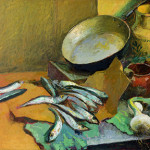
Most of us know Anchovies from Caesar Salad Dressing. Lately, at some of the better restaurants, we’ve been seeing White Anchovies across the top of a Caesar….
According to Chowhound, white anchovies are:
Simply anchovies that are filleted and then marinated in white vinegar. These are popular in Sicily.
And what most people don’t know, or realize, is that fresh anchovies have a much softer and gentler taste than processed anchovies. The strong taste that people associate with anchovies is due to (various) curing processes.
I was with some friends the other night and someone asked me the difference between white and regular anchovies (the ones you find all curled up and soaking in oil)?
Well, now we see that the white ones are marinated in vinegar. That makes for a ‘less hit you over the head’ taste. But lets find out why the ones we see at the store are so strong. (Those by the way, are the ones you want to use in a Caesar Salad Dressing if you really want that strong anchovy taste that you just can’t duplicate any other way). I’m salivating! lol
According to Wiki: “A traditional method of processing and preserving anchovies is to gut and salt them in brine, allow them to mature, and then pack them in oil or salt. This results in a characteristic strong flavor and the flesh turns deep grey”.
It doesn’t come up on the list of ‘bad for you, high in mercury’. Instead, we hear more about the Omega 3 benefits. Both Sardines and Anchovies are usually muttered in the same breath when we talk about fish you should be eating more of.
Are you thinking you might want to experiment with anchovies?
Here’s Ina Garten’s recipe from the Food Network. Serves 8
Ingredients
3/4 pound pancetta, sliced 1/2-inch thick
2 pints cherry tomatoes
Good olive oil
Kosher salt
Freshly ground black pepper
2 large heads romaine lettuce
1 cup freshly grated Parmesan
For the dressing:
1 extra-large egg yolk at room temperature*
2 teaspoons Dijon mustard
2 large cloves garlic, chopped
8 to 10 anchovy fillets (optional)
1/2 cup freshly squeezed lemon juice (3 lemons)
2 teaspoons kosher salt
1/2 teaspoon freshly ground black pepper
1 1/2 cups good mild olive oil
1/2 cup freshly grated Parmesan cheese
Directions
Preheat the oven to 400 degrees F.
Cut the pancetta into 1/2-inch cubes and cook it in a skillet over medium-low heat for 10 to 15 minutes, until browned and crisp. Remove to paper towels and drain.
Place the tomatoes on a baking sheet and coat with olive oil. Sprinkle with salt and pepper. Roast for 15 to 20 minutes, until soft.
Wash the lettuce leaves carefully and spin-dry in a salad spinner. Stack the leaves on a cutting board and cut them crosswise into 1 1/2-inch slices. Place them in a large mixing bowl.
For the dressing, place the egg yolks, mustard, garlic, anchovies, lemon juice, salt, and pepper into the bowl of a food processor fitted with a steel blade. Process until smooth. With the food processor running, slowly pour the olive oil through the feed tube (as though you were making mayonnaise), until thick. Add the grated Parmesan cheese and pulse 3 times.
Toss the lettuce with enough dressing to moisten well. Add 1 cup grated Parmesan and toss. Divide the lettuce among 6 or 8 plates and sprinkle with the pancetta roasted tomatoes. Serve at room temperature.
All these ingredients can be made in advance. Be sure they’re room temperature when you assemble the salad.
If you’re nervous about raw egg yolks, substitue 2 tablespoons of real mayonnaise.
Pancetta is Italian bacon. You can find it in your Italian grocery or a specialty food store. Insist that it’s vut 1/2-inch thick.
* Raw Egg Warning
Food Network Kitchens suggest caution in consuming raw and lightly cooked eggs due to the slight risk of salmonella or other food-borne illness. To reduce this risk, we recommend you use only fresh, properly refrigerated, clean grade A or AA eggs with intact shells, and avoid contact between the yolks or whites and the shell. For recipes that call for eggs that are raw or undercooked when the dish is served, use shell eggs that have been treated to destroy salmonella, by pasteurization or another approved method.
Happy Eating,
Chef Marian